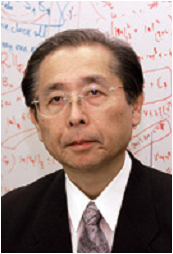
ページ読込中...

ページ読込中...

[English]
| 大谷 光春 [教授] |  |
|
| homepage | ||
| 専門分野 | 非線形関数解析学研究 | |
| 研究テーマ・研究活動 | ||
| 1973 年 早稲田大学応用物理学科卒業 1978 年 東京大学大学院理学系研究科博士課程修了 1978 年 理学博士(東京大学) 1981 年 東海大学理学部数学科助教授 1990 年 東海大学理学部数学科教授 1990 年 早稲田大学理工学部教授 |
||
物理学や工学などに現れる重要な現象のほとんどは、「偏微分方程式」(複数の独立変数による微分が現れる微分方程式)によって記述されており、その多くは、「非線形性」と呼ばれる、「二つの解の足し算が必ずしも解にならない」という際立った性質をもっています。
これらの解を探す場所(空間)として、バナッハ空間やヒルベルト空間(ピタゴラスの定理が成り立つようなユークリッド空間の拡張概念)などと呼ばれる、無限次元空間をとり、ここでどのような解析学が成り立つかを研究する立場をとる学問が、「関数解析学」です。
無限次元の世界においては、有限次元における解析学と同様な多くの事実が成り立つと同時に、有限次元の常識では考えられない不思議なことも多く起こります。たとえば無限次元ヒルベルト空間においては、ベクトル列の収束(ベクトル列が、あるベクトルに近づいていくこと)に関して、強収束と弱収束という2 種類の定義ができますが、有限次元の場合、これらは同等な性質となってしまいます。さらに、有限次元空間においては、あるベクトル列が、長さを1に保ちながら0ベクトルに収束することは不可能ですが、無限次元空間ヒルベルト空間における弱収束の世界では、これが可能になります。
大谷研究室では、無限次元空間における非線形微分方程式を、主に、変分法的観点から研究しています。「変分法」とは、「物理法則に従って動く質点の運動や光の径路は、すべての可能な運動や径路のなかで、ある物理量を最小にするように選ばれている」すなわち、「自然は無駄をしない」という原理に基づく解析手法の総称です。
研究室において最近、「多孔質媒質方程式(均一に孔が分布している媒質中を水などが拡散するモデル)が無限回微分可能な解を許す」という長年の未解決問題が、肯定的に解決されるという大きな成果がありました。
あなたも、私たちと一緒に無限次元空間を変分法というコンパス( 羅針盤) をもって探検してみませんか?
| Mitsuharu Otani [Professor] |  |
|
| homepage | ||
| research field | Nonlinear Functional Analysis and its applications to nonlinear PDEs | |
| research keywords | ||
| Functional Analysis Nonlinear PDEs Nonlinear Evolution Equations Variational Method |
||
| link | ||
| Research Profiles (at Faculty of Science and Engineering) | ||
Nonlinear Partial Differential Equations: Differential Equations are the language in which the laws of nature are expressed. Understanding properties of solutions for differential equations is fundamental to much of contemporary science and engineering. Ordinary Differential Equations (ODEs) deal with functions of one variable, which can often be thought of as time. On the other hand, Partial Differential Equations (PDEs) deal with functions of several variables (of space and time). Most fundamental laws in physics are expressed in terms of Nonlinear PDEs, where the nonlinearity means that the sum of two solutions of the equations could not be a solution anymore, in other words, the principle of the superposition does not hold.
Evolution Equations: A function u(x,t) solving PDEs with time evolution depends on several variables, i.e., “x” for space and “t” for time. However, we can regard u(x,t) as a function u(t) of one variable “t” with value of u( ,t), which would lie in an infinite dimensional space X.
In this way, PDEs with time evolution can be reduced to ODEs in infinite dimensional spaces.
In fact, Heat Equations, Wave Equations, Schrodinger Equations, and many other important PDEs in physics and engineering can be written in abstract ODEs of the form: (E) du(t)/dt + Au(t) =0 in appropriate spaces X, called Banach spaces, and with operators A which work on X. In order to analyze this type of ODE, we must develop the theory of ODEs in Banach spaces, which is called the “Theory of Evolution Equations.” For this purpose, we need knowledge related to calculus in infinite dimensional spaces, called “Functional Analysis.”
Nonlinear Functional Analysis: Some important Nonlinear PDEs such as “Porous Medium Equations” (equations describing the diffusion process through porous mediums) are formulated as (E) by choosing suitable nonlinear operators A. In order to treat these cases, the theories of Nonlinear Evolution Equations and Nonlinear Functional Analysis are needed. Among them, the Nonlinear Semi-group Theory, which was initiated and developed by Japanese mathematicians, provides a remarkable tool. In particular, this theory reflecting the variational structure, called the subdifferential operator theory, which deals with the case where A is given as the functional derivative f(u) of convex functional f(u), is a most successful one for applications to Nonlinear PDEs. However, these theories work only for dissipative systems, whose energy is a monotone decreasing in time t, but cannot cover non-dissipative systems such as Navier-Stokes Equations, which is the fundamental equation in fluid dynamics.
We have been developing the perturbation theory for subdifferential operators, aiming at its application for not only Navier-Stokes-type equations but also for a wider class of non-dissipative PDEs systems including Nonlinear PDEs with nonlinear boundary conditions.
Other Topics: Our main interest is also related to the analysis of the asymptotic behaviors of solutions to Nonlinear PDEs, such as the blow-up of solutions and the existence of global attractors, etc., as well as seeking underlying hierarchical structures between the parabolicity and hyperbolicity of PDEs.